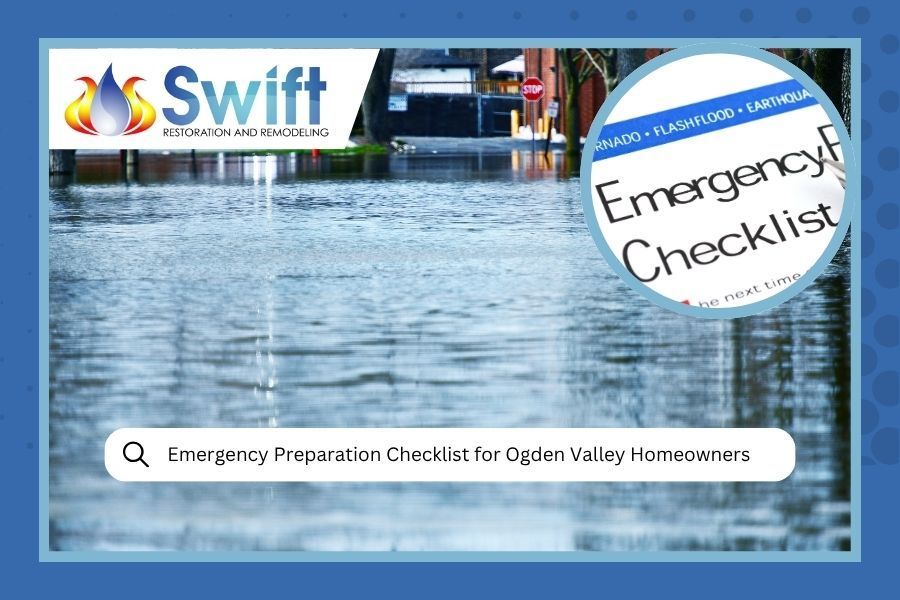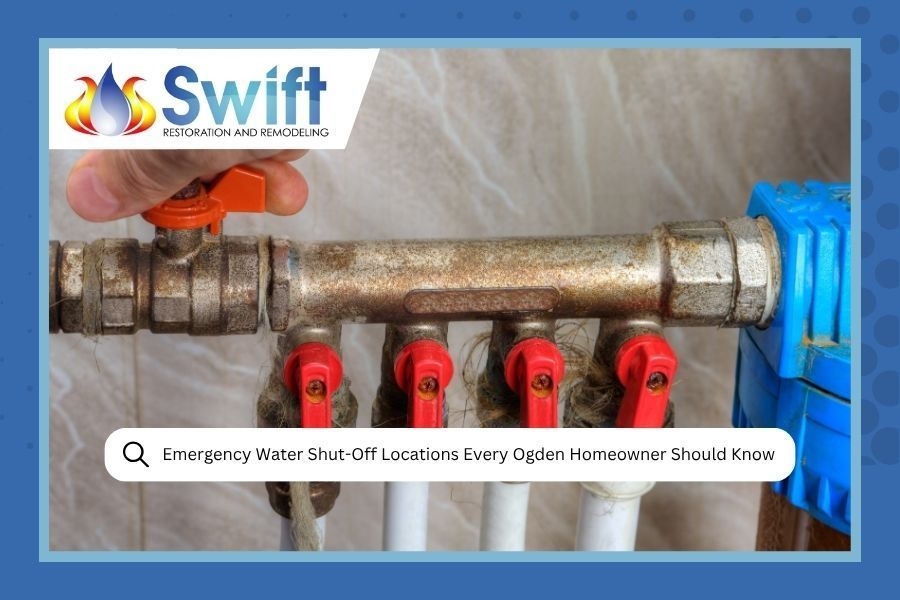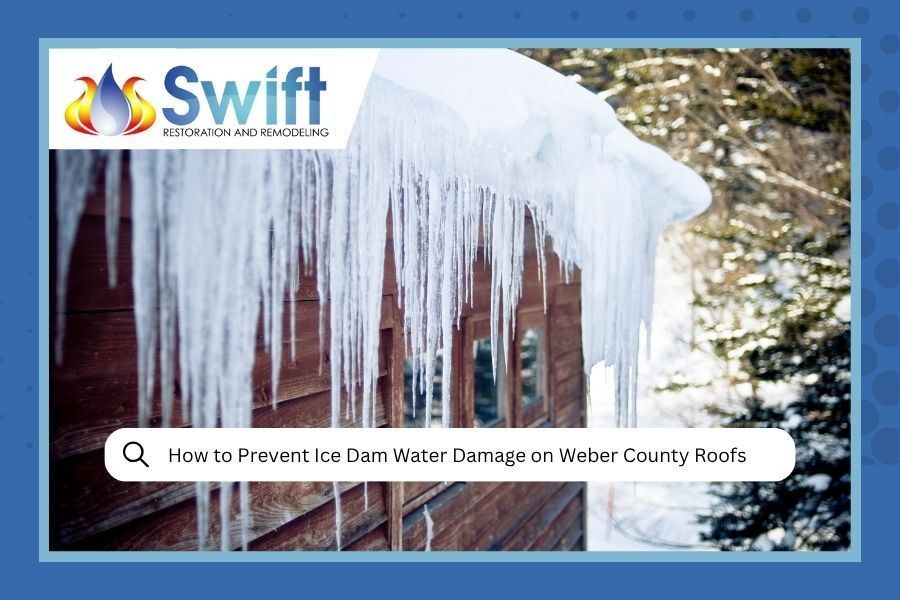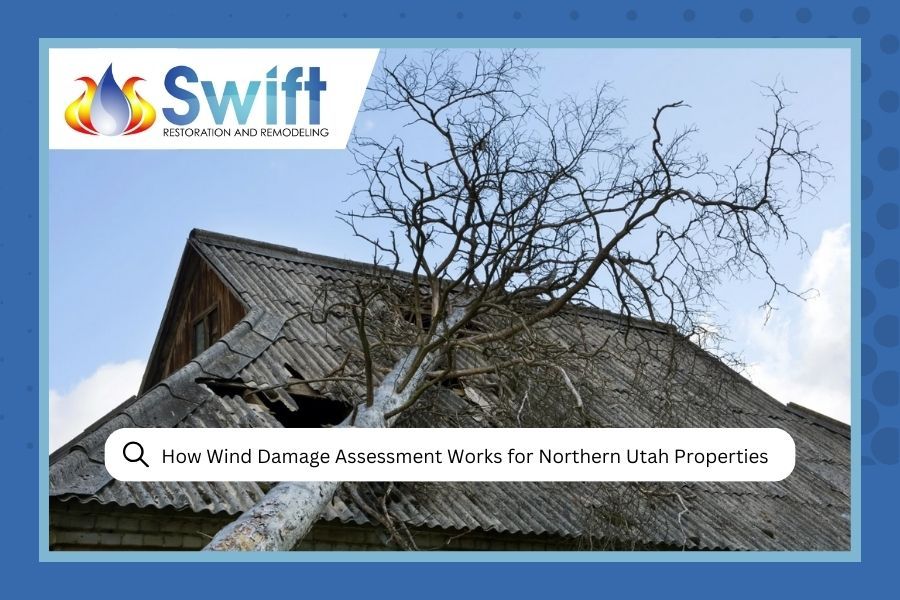
Author: Darin Jenks
Jump To Section
When the winds pick up in Northern Utah, they don't mess around. We've all been there, watching our patio furniture take flight or hearing that unsettling sound of something hitting the roof. If you've recently experienced a windstorm and you're wondering about the state of your property, understanding how wind damage restoration works can save you time, money, and a lot of headaches down the road.
At Swift Restoration and Remodeling, we've helped countless Northern Utah homeowners navigate the wind damage assessment process. While every storm is different, the evaluation process follows some pretty standard steps that help determine exactly what happened to your home and what needs to be fixed.
What Exactly Is Wind Damage Assessment?
Think of wind damage assessment like getting a thorough checkup for your home after a storm. It's a systematic evaluation where trained professionals examine your property from top to bottom, looking for any damage that high winds might have caused. This isn't just about the obvious stuff you can see from the ground, either.
A proper wind damage assessment covers everything from loose shingles and damaged siding to more subtle issues like compromised structural integrity or problems with your home's envelope (that's the fancy term for everything that separates your indoor and outdoor environments).
Ready to Get Your Property Assessed After Recent Wind Damage?
Our team at Swift Restoration and Remodeling provides thorough evaluations and can help restore your home to its pre-damage condition.
Get Your Free Estimate TodayUnderstanding Wind Damage Types in Northern Utah
Roof Damage
Your roof takes the biggest beating during windstorms. Missing or damaged shingles, exposed underlayment, and damaged flashing are common issues we see. Sometimes the damage is obvious, like when you find shingles scattered across your lawn. Other times, it's more subtle, like lifted shingle tabs that create entry points for water. Understanding what causes a leaking roof and how to prevent them can help you spot potential issues early.
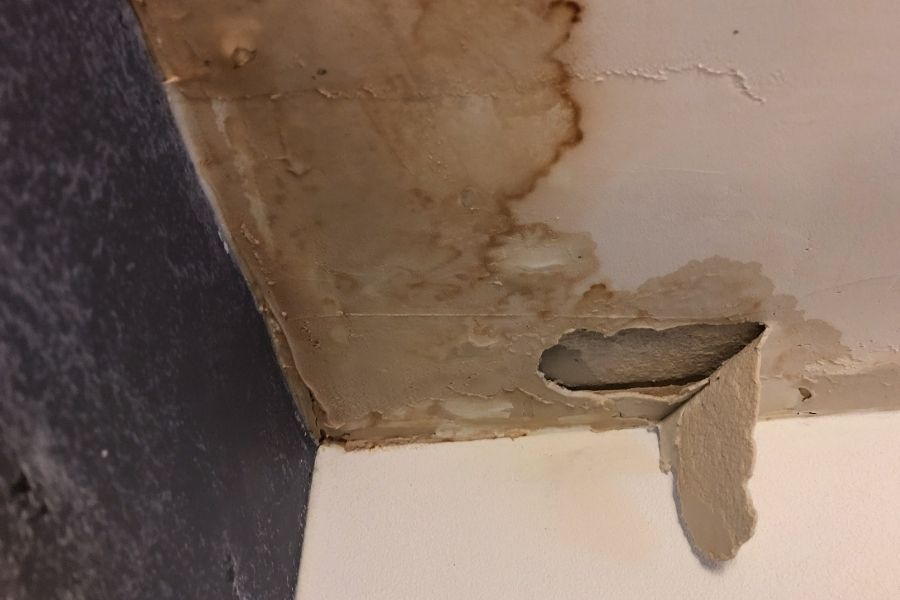
Siding and Exterior Damage
High winds can cause dents, cracks, or complete sections of siding to come loose. We also frequently see damage to gutters, downspouts, and exterior fixtures. Storm cleanup often involves addressing multiple types of exterior damage at once.
Window and Door Issues
Pressure changes during severe windstorms can cause windows to crack or even blow out entirely. Doors may be damaged or thrown off their tracks. These issues need immediate attention since they compromise your home's security and weather resistance.

Hidden Structural Problems
This is where professional assessment becomes crucial. Wind can stress your home's frame in ways that aren't immediately visible but could cause problems later if not addressed.
Wind Damage Assessment Timeline
Immediate
Safety evaluation and emergency repairs
24-48 Hours
Comprehensive exterior inspection
3-5 Days
Interior assessment and documentation
1-2 Weeks
Insurance claim submission and repair planning
The Professional Wind Damage Assessment Process
Step 1: Initial Safety Evaluation
Before anything else, we check to make sure your property is safe to enter and evaluate. Sometimes wind damage can create hazardous conditions that need to be addressed before a thorough assessment can begin.
Step 2: Exterior Inspection
We start from the outside, working our way around your entire property. This includes:
- Roof inspection (often using drones for safety and better visibility)
- Siding, gutters, and trim examination
- Window and door assessment
- Yard and outbuilding evaluation
Step 3: Interior Assessment
Next, we move inside to check for:
- Water intrusion signs
- Structural stress indicators
- Window and door function
- Any interior damage from debris
Step 4: Documentation and Reporting
Everything gets photographed, measured, and documented. This detailed record is essential for insurance claims and repair planning. Professional assessors follow standardized procedures, and you can learn more about official assessment protocols from FEMA's Preliminary Damage Assessment Guide.
Step 5: Repair Prioritization
Finally, we help you understand what needs immediate attention versus what can wait, helping you make informed decisions about your repairs.
Schedule Your Professional AssessmentWhy Professional Assessment Matters
You might be wondering, "Can't I just look at my house myself and figure out what's damaged?" While you can certainly spot obvious problems, there's a lot that trained eyes catch that most homeowners miss. We've seen situations where homeowners thought they just needed a few shingle replacements, only to discover significant structural issues during professional evaluation.
Professional assessment also provides the documentation you need for insurance claims. Insurance companies want detailed reports with photos, measurements, and professional opinions about what damage is storm-related versus pre-existing. Knowing the signs of water damage helps distinguish between wind damage and other issues.
Wind Damage Assessment Checklist for Homeowners
Here's what you can look for before professionals arrive:
| Area to Check | What to Look For | Priority Level |
|---|---|---|
| Roof (from ground) | Missing shingles, exposed areas, debris | High |
| Siding | Dents, cracks, loose sections | Medium |
| Windows | Cracks, broken glass, frame damage | High |
| Doors | Won't close properly, frame damage | Medium |
| Gutters | Dents, loose sections, debris buildup | Medium |
| Interior Ceilings | Water stains, sagging, new cracks | High |
| Interior Walls | New cracks, drafts around openings | Low |
Safety Note: Don't climb on your roof or use ladders in windy conditions. Take photos from the ground and leave the dangerous stuff to the professionals.
Common Wind Damage Assessment Mistakes
Assuming Minor Damage Means No Problems
Just because you can only see a few loose shingles doesn't mean that's the extent of the damage. Wind can cause problems that develop over time if not properly addressed.
Waiting Too Long to Get Assessed
The sooner you have damage assessed, the better. Not only can additional weather worsen existing damage, but insurance companies often have time limits for filing claims.
Trying to DIY Everything
While we're all for homeowner independence, wind damage can be tricky. What looks like a simple fix might actually indicate larger problems that need professional attention. For example, ceiling stains from roof damage require understanding how to handle ceiling water damage repair properly.
What to Expect During Your Assessment
When our team comes out for a wind damage assessment, plan on the process taking a few hours for a thorough evaluation. We'll walk you through our findings as we go, explaining what we're seeing and what it means for your home.
You don't need to prepare much ahead of time, but it's helpful if you can:
- Clear paths around your home's exterior
- Make note of any interior issues you've noticed
- Gather any documentation of recent improvements or repairs
- Have your insurance information handy
Working with Your Insurance Company
A professional wind damage assessment often becomes the foundation for your insurance claim. We work with insurance adjusters regularly and understand what they need to see. Our detailed documentation and professional opinions can help ensure your claim is processed fairly and completely.
Remember, you have the right to choose your own contractors for repairs. You're not required to use whoever your insurance company might suggest, and sometimes the contractors insurance companies recommend may not be local or may not have the same level of expertise with Northern Utah's unique weather challenges.
Don't Wait - Professional Assessment Protects Your Investment
The longer wind damage sits unaddressed, the more problems it can create. Our experienced team provides thorough evaluations and works directly with insurance companies to streamline your claims process.
Available 24/7 for Emergency Situations
Get Your Free Assessment TodayWhy Choose Swift Restoration and Remodeling
We understand Northern Utah weather patterns and the specific types of wind damage common in our area. From the Ogden Valley winds to the storms that sweep down from the mountains, we've seen it all and know how to properly assess and repair wind damage.
Our team has over 13 years in the restoration industry, and we're available 24/7 for emergency situations. We also handle the entire process from assessment through complete restoration, so you don't need to coordinate with multiple contractors.
We're also familiar with local building codes and permit requirements, ensuring any repairs meet current standards. Plus, we work directly with insurance companies to help streamline your claims process.
If you're dealing with wind damage to your Northern Utah property, don't wait to get a professional assessment. The longer damage sits unaddressed, the more problems it can create. Contact Swift Restoration and Remodeling today for expert wind damage evaluation and restoration services throughout the Ogden area and surrounding communities.
FAQ: Wind Damage Assessment in Northern Utah
How soon after a windstorm should I get my property assessed?
As soon as it's safe to do so. Ideally within 24-48 hours of the storm. Quick assessment helps prevent additional damage and ensures you meet insurance claim deadlines. Our team provides 24/7 emergency response for urgent situations.
Will my insurance cover the cost of a professional wind damage assessment?
Many insurance policies cover the cost of professional assessment when it's part of a legitimate claim. We work directly with insurance companies and can help you understand your coverage options during the evaluation process.
What's the difference between wind damage and normal wear and tear?
Wind damage typically shows specific patterns like directional damage, debris impact marks, or sudden failure of materials. Normal wear shows gradual deterioration over time. Our experienced team can help distinguish between the two for insurance purposes.
Can wind damage get worse if I wait to address it?
Absolutely. Even small areas of roof damage can allow water infiltration that leads to mold, rot, and structural problems. What might be a simple shingle replacement today could become a major restoration project if left unaddressed through more weather events.


